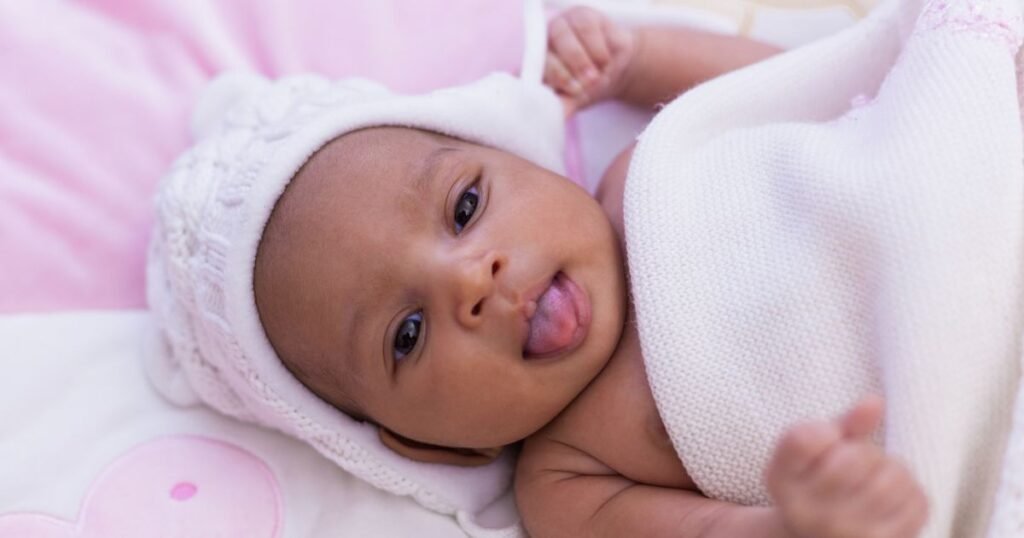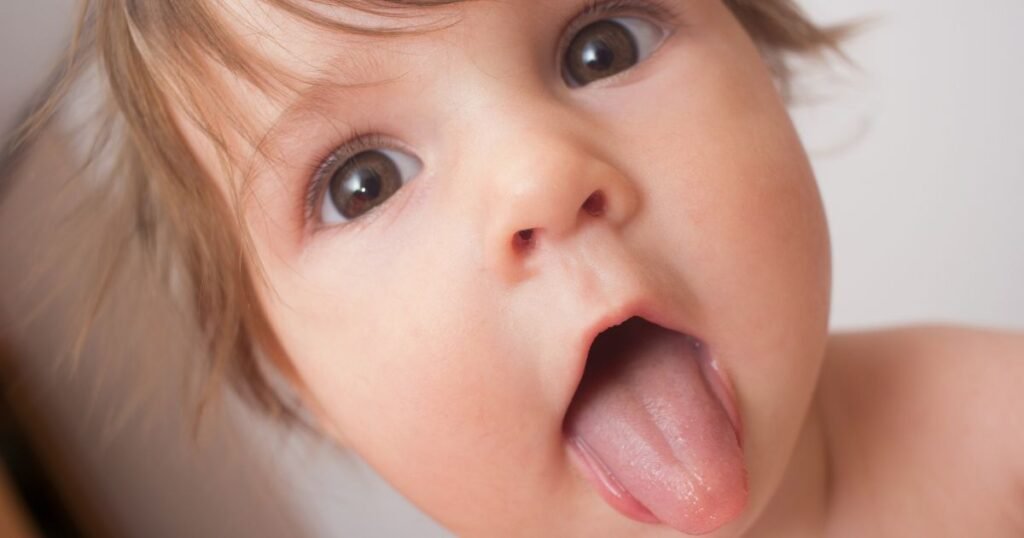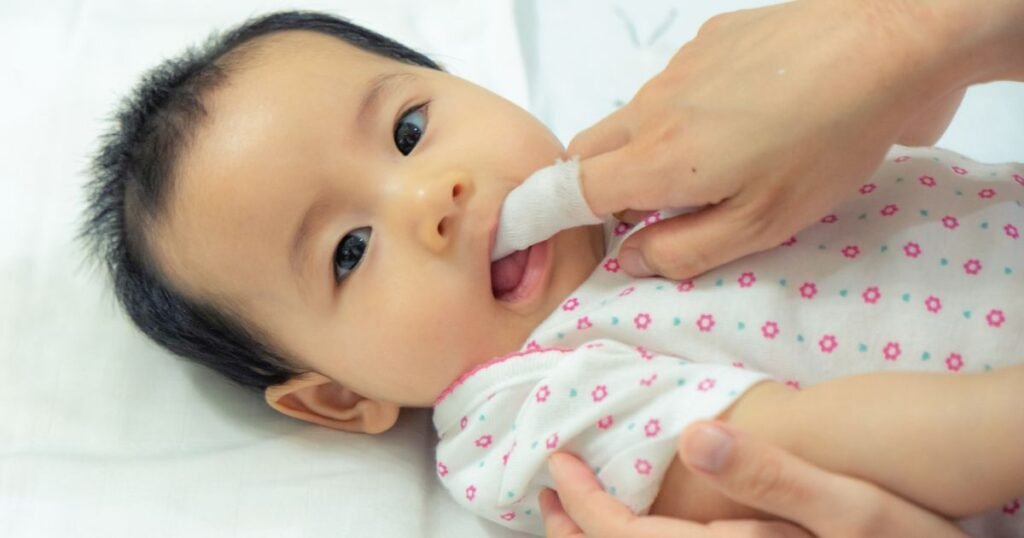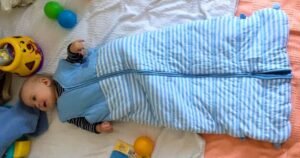Last Updated on 12 March 2024
Newborns don’t consume solid foods, so many parents assume that their babies don’t need any oral cleaning. However, this is not the case. The milk that babies consume can leave residue on their tongues, putting them at risk of developing microbial growth. One out of every seven newborn babies suffers from oral thrush, which is a common fungal infection. Unfortunately, many of these cases occur due to the negligence of parents who do not clean their newborn’s tongue regularly.
To avoid such infections and maintain good oral hygiene for your newborn, it is essential to learn how to clean newborn tongue. Cleaning your newborn’s tongue not only removes milk residue but also helps prevent gum disease and tooth decay. It is important to establish good oral care habits from an early age, as this will benefit your child’s oral health in the long run.
In this ultimate guide, we will provide you with a step-by-step process on how to effectively clean your newborn’s tongue. We will discuss the importance of newborn tongue cleaning, common concerns about oral hygiene, and provide tips on choosing the right tools for the job. So let’s dive in and learn how to keep your newborn’s tongue clean and healthy.
Understanding the Importance of Newborn Tongue Cleaning
Maintaining good oral hygiene for newborns is crucial for their overall health and development. Newborns are at risk of developing oral infections if proper oral care is not maintained. Milk residue left on the tongue can promote the growth of bacteria and fungi, leading to conditions such as oral thrush. Regular cleaning of the newborn tongue helps remove these harmful substances and prevents the onset of oral health issues.
Why It is Essential to Clean Your Newborn’s Tongue
Cleaning your newborn’s tongue is essential for several reasons. Firstly, it helps maintain overall oral hygiene by removing milk residue and preventing the growth of bacteria and fungi. Without proper cleaning, these substances can accumulate and lead to gum disease and tooth decay in newborns. Regular tongue cleaning also helps in the development of healthy teeth and gums.
By establishing good oral care habits from an early age, you can set your child up for a lifetime of good oral health. Additionally, cleaning your newborn’s tongue promotes awareness of oral hygiene, which can lead to a better understanding and practice of oral care as they grow older. It is important to incorporate tongue cleaning into your baby’s daily routine to ensure optimal oral health.
Common Concerns About Newborn Oral Hygiene
Parents often have concerns and questions about newborn oral hygiene. One common concern is when to start cleaning their newborn’s mouth and tongue. It is recommended to start cleaning the newborn’s tongue as early as a few weeks after birth. This can be done using a soft cloth or a tongue cleaner designed for babies. Another concern is the risk of oral thrush, a common fungal infection in newborns. Oral thrush can cause discomfort and white patches on the tongue. If you notice any signs of oral thrush, it is important to consult a pediatric dentist for proper diagnosis and treatment.

Parents may also wonder when the first tooth will appear and when to start using toothpaste. The first tooth usually appears around six months of age, and at that point, a rice-sized amount of toothpaste can be used. It is important to use fluoride-free toothpaste until the child can spit it out. These common concerns can be addressed by following proper oral hygiene practices and consulting a pediatric dentist for guidance.
Preparing for Your Newborn’s Tongue Cleaning
Before you start cleaning your newborn’s tongue, it is important to prepare the necessary tools and create a suitable environment. Good oral health starts with clean hands, so make sure to wash your hands thoroughly with warm water and soap before beginning the cleaning process. This helps prevent the transfer of germs to your baby’s mouth. Next, gather a piece of clean and soft gauze or a soft cloth that will be used to clean the tongue. It is important to choose a cloth that is gentle and smooth to avoid any irritation to your baby’s tongue. By preparing these simple tools, you can ensure a safe and effective tongue-cleaning process for your newborn.
What You Need Before You Start
Before you start cleaning your newborn’s tongue, it is important to gather the necessary tools to ensure proper cleaning. Here are the items you will need:
- Finger brush: A finger brush is a small brush that fits over your finger and has soft bristles. It allows you to clean your baby’s mouth and tongue gently.
- Damp cloth: A clean and damp cloth can be used to wipe your baby’s tongue and remove any milk residue or bacteria.
- Tongue cleaner: A tongue cleaner specifically designed for babies can also be used to clean the tongue effectively. It helps remove any buildup or residue on the tongue’s surface.
To start the cleaning process, make sure your hands are clean and dry. Gently insert your finger brush or damp cloth into your baby’s mouth, being careful not to touch the back of their throat. Move the brush or cloth in gentle circular motions on the tongue’s surface, removing any debris or residue. Take your time and be patient, as your baby may be sensitive to the sensation of cleaning. Repeat this process as needed to ensure a thorough cleaning of your baby’s tongue.
When Is the Right Time to Clean Your Newborn’s Tongue?
Cleaning your newborn’s tongue should be done in the early stages of their life. Even before their first teeth appear, it is important to establish a routine for cleaning their tongue. You can start cleaning your newborn’s tongue a few weeks after birth, as this is when milk residue and bacteria can start to accumulate on the tongue’s surface.
Cleaning your newborn’s tongue should be done regularly, especially after feedings. This helps remove any milk residue and bacteria that may be present in their mouth. As your baby’s first teeth start to appear, it becomes even more important to clean their tongue regularly. The presence of teeth creates additional areas where bacteria can accumulate.
By cleaning your newborn’s tongue regularly, you are promoting good oral hygiene and preventing the risk of gum disease and tooth decay. It is a simple and effective practice that should be incorporated into your baby’s daily routine.
Step-by-Step Guide on How To Clean Newborn Tongue
Cleaning your newborn’s tongue is a simple process that can be done with the help of a baby tongue cleaner or a soft cloth. Here is a step-by-step guide to cleaning your newborn’s tongue:
- Wash your hands thoroughly with warm water and soap to ensure they are clean and germ-free.
- Hold your baby in a comfortable position, either on your lap or on a changing table.
- Gently open your baby’s mouth and insert the baby tongue cleaner or the soft cloth.
- Using gentle pressure, move the cleaner or cloth in a circular motion on the tongue’s surface. Start from the back of the tongue and move towards the front.
- Repeat this motion a few times to ensure a thorough cleaning of the entire tongue.
- Rinse the baby tongue cleaner or cloth with warm water and dry it before the next use.
By following these steps, you can effectively clean your newborn’s tongue and promote good oral hygiene.
Choosing the Right Tool: Washcloth, Gauze, or Finger Brush?
When it comes to cleaning your newborn’s tongue, you have a few options for tools. The choice between a washcloth, gauze, or finger brush depends on your preference and what works best for your baby.
A washcloth is a soft and gentle option that can be used to wipe your baby’s tongue. Simply dampen the washcloth with warm water and gently wipe the tongue’s surface. Make sure the washcloth is clean and free of any harsh chemicals or detergents.
Gauze is another option that can be used to clean your baby’s tongue. Take a small piece of clean gauze and wrap it around your finger. Dampen the gauze with warm water and use it to gently clean the tongue in a circular motion. This method allows for more control and precision while cleaning.

A finger brush is a small brush that fits over your finger and has soft bristles. It can be used to gently clean your baby’s tongue. Simply insert your finger with the finger brush into your baby’s mouth and move it in a circular motion on the tongue’s surface.
Ultimately, the choice of tool depends on what you and your baby are comfortable with. Experiment with different options to find the one that works best for you.
How To Clean Newborn Tongue Safely
When cleaning your baby’s tongue, it is important to do so safely and gently to avoid any discomfort or irritation. Here are some tips on how to safely and gently clean your baby’s tongue:
- Use a soft cloth or a baby tongue cleaner with soft bristles to ensure a gentle cleaning experience.
- Start at the back of the tongue and move towards the front in a gentle, circular motion. This helps remove any residue or buildup on the tongue’s surface.
- Apply gentle pressure while cleaning to avoid causing any discomfort or injury to your baby’s tongue.
- Avoid using excessive force or hard bristles, as this can irritate the tongue and potentially cause bleeding.
- Take breaks if your baby becomes fussy or uncomfortable during the cleaning process. You can try using soothing techniques such as gentle rocking or singing to help calm your baby.
- Be patient and understanding, as it may take some time for your baby to get used to the sensation of tongue cleaning.
Common Challenges in Newborn Tongue Cleaning
Cleaning your newborn’s tongue may present some challenges, especially if your baby becomes fussy or resistant during the process. It is important to address these challenges and find ways to overcome them.
One common challenge is dealing with a fussy baby during tongue cleaning. Some babies may not enjoy the sensation or become irritated by the process. In such cases, try to create a calm and soothing environment before starting the cleaning. Use gentle techniques such as rocking or singing to help calm your baby.
Another challenge is effectively removing milk residue from the tongue’s surface. Milk residue can leave a white coating on the tongue, which may be difficult to remove. To address this challenge, make sure you are thorough in your cleaning and use a gentle, circular motion to remove the residue. If the residue persists, consult a pediatric dentist for further advice.
By addressing these common challenges and finding suitable solutions, you can ensure effective and comfortable tongue cleaning for your newborn.
Dealing with a Fussy Baby During Cleaning
Cleaning your newborn’s tongue can sometimes be challenging if your baby becomes fussy or resistant. It is important to find ways to calm and soothe your baby during the cleaning process. Here are some techniques to help deal with a fussy baby during tongue cleaning:
- Create a calm environment: Find a quiet and comfortable space to perform the tongue cleaning. Dim the lights and eliminate any distractions to create a soothing environment for your baby.
- Use soothing techniques: Try using gentle rocking or swaying motions to help calm your baby. You can also sing a lullaby or play soft music to create a relaxing atmosphere.
- Take breaks: If your baby becomes fussy or agitated, take breaks during the cleaning process. Allow your baby to calm down before continuing with the cleaning. This will help prevent any undue stress or discomfort for your baby.
- Be patient: It is important to remain patient and understanding during the cleaning process. Your baby may need some time to adjust to the sensation of tongue cleaning. Stay calm and continue with the process, ensuring that you are gentle and comforting.
By implementing these techniques and maintaining a calm and soothing environment, you can help make the tongue-cleaning process more comfortable for your fussy baby.
How to Spot and Remove Milk Residue Effectively
Milk residue can leave a white coating on your baby’s tongue, which may be difficult to remove. Spotting and effectively removing this residue is important for maintaining good oral hygiene. Here’s how to spot and remove milk residue effectively:
- Spotting milk residue: Look for white spots or a white coating on your baby’s tongue. These can indicate the presence of milk residue. Regularly inspect your baby’s tongue to identify any buildup.
- Removing milk residue: To remove milk residue, use a soft cloth or a baby tongue cleaner with soft bristles. Gently wipe or brush the tongue’s surface in a circular motion. This helps dislodge the residue and remove it from the tongue.
Tips to Prevent Oral Health Issues in Newborns
Preventing oral health issues in newborns is essential for their overall well-being. Here are some tips to help prevent oral health issues in your newborn:
- Clean your baby’s mouth and tongue regularly to remove breast milk or formula residues.
- Avoid putting your baby to sleep with a bottle, as this can lead to the buildup of plaque and the development of cavities.
- Limit your baby’s consumption of sugary drinks and foods, as these can contribute to tooth decay.
- Use a soft-bristled toothbrush or a finger brush with soft bristles to clean your baby’s teeth and gums.
- Avoid using excessive pressure or force while cleaning to prevent irritation or injury.
Signs That Indicate You Should Consult a Pediatrician or Dentist
While regular oral care is important, certain signs indicate you should consult a pediatrician or dentist for professional advice. Here are some signs to watch out for:
- Oral thrush: If you notice white patches on your baby’s tongue or cheeks that do not wipe away easily, it could be a sign of oral thrush. Consult a healthcare professional for proper diagnosis and treatment.
- Bad breath: Persistent bad breath in your baby could be a sign of an underlying oral health issue. A healthcare professional can help identify the cause and provide appropriate treatment.
- Difficulty feeding: If your baby is having trouble feeding or shows signs of discomfort during tongue cleaning, it may be necessary to seek professional advice.
- Any other concerns: If you have any concerns or questions about your baby’s oral health, it is always best to consult a healthcare professional for guidance.
By seeking professional advice when necessary, you can ensure that your baby receives the appropriate care and treatment for any oral health concerns.
Cleaning your newborn’s tongue is an essential part of their oral hygiene routine. By gently removing milk residue and establishing a cleaning routine early on, you can prevent potential oral health issues. Whether using a washcloth, gauze, or finger brush, ensure it’s done softly and safely. Remember, seeking professional advice when necessary is crucial for your baby’s oral health. Stay informed, start early, and nurture a healthy oral care regimen for your little one’s well-being.
Frequently Asked Questions
AUTHOR BIOGRAPHY









